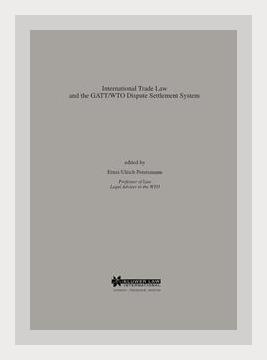Business Law and EthicsInternational Trade Law
**
Introduction
Ernst-Ulrich Petersmann’s 1997 book “International Trade Law and the GATT/WTO Dispute Settlement System” is a comprehensive examination of the mechanisms and effectiveness of the dispute settlement system within the General Agreement on Tariffs and Trade (GATT) and World Trade Organization (WTO). This work meticulously details the legal frameworks, historical evolution, and practical operations of these international trade bodies, emphasizing that the dispute settlement system plays a pivotal role in enforcing trade laws among member nations.
1. Evolution of the GATT/WTO Dispute Settlement System
Petersmann begins by tracing the historical background of GATT, established in 1947, and its evolution into the WTO in 1995. He points out that the original GATT dispute settlement process was ad-hoc and lacked binding enforcement mechanisms. The introduction of the WTO introduced a more structured and compulsory dispute settlement system, aiming to solve the issues inherent in GATT’s more primitive model.
Actionable Advice: Legal scholars and trade professionals should familiarize themselves with the historical context of these systems to understand contemporary practices better. For instance, analyzing past GATT cases can provide insights into how certain trade principles have evolved over time.
2. Legal Framework of the WTO Dispute Settlement System
The author explains the legal underpinnings of the WTO’s dispute settlement system (DSS) as enshrined in the Understanding on Rules and Procedures Governing the Settlement of Disputes (DSU). The DSU provides a structured timeline and mandatory compliance criteria for dispute resolution.
Concrete Example: The book discusses the US-Gasoline case, illustrating how the WTO DSS operates, from consultations to the formation of a panel and the appellate process.
Actionable Advice: Legal advisors can advise their clients on the procedural stages of lodging a complaint with the WTO, ensuring that they are well-prepared for each phase, from consultations to compliance.
3. Role of Panels and the Appellate Body
A significant portion of the book is dedicated to the functioning of panels and the Appellate Body. Petersmann explains that panels are composed of experts who initially review cases, while the Appellate Body serves to review panel decisions when contested.
Concrete Example: The EC-Hormones case is cited, showing how a panel’s ruling was later reviewed and clarified by the Appellate Body, setting a precedent for future sanitary and phytosanitary measures.
Actionable Advice: Trade lawyers should effectively prepare for both stages—panel hearings and potential appellate reviews. Detailed legal briefs and thorough preparations can significantly influence the outcomes at both levels.
4. Compliance and Enforcement Mechanisms
Petersmann emphasizes the importance of compliance mechanisms within the WTO, which ensure that member states adhere to the rulings. Non-compliance can lead to authorized retaliatory measures by the winning party.
Concrete Example: The book discusses the Canada-Aircraft and Brazil-Aircraft disputes, where authorized retaliation was used as a tool to enforce compliance.
Actionable Advice: Practitioners should advise their clients on the implications of not complying with WTO rulings, including the potential for trade sanctions or retaliatory measures by other member states. Firms should plan compliance strategies proactively to avoid such outcomes.
5. Impact on Developing Countries
The author also focuses on the particular challenges and opportunities for developing countries within the WTO dispute settlement framework. The procedural complexities and resource requirements can be daunting for less developed nations.
Concrete Example: Petersmann cites the US-Cotton case, where Brazil, a developing country, successfully challenged US cotton subsidies.
Actionable Advice: Developing countries should seek technical assistance and capacity-building support available through the WTO and other international organizations to effectively participate in the dispute settlement process. Building legal expertise domestically or hiring international legal expertise can leverage their position in trade disputes.
6. Criticisms and Reforms of the Dispute Settlement System
The book is not shy about addressing criticisms of the WTO DSS. Petersmann discusses issues such as the length of time taken to resolve disputes and the perceived bias towards wealthier nations. He also articulates potential reforms to address these concerns.
Concrete Example: The book references the prolonged timeline of the Australia-Salmon consultations and panel processes as an example of procedural delays.
Actionable Advice: Engage in advocacy for reform within the WTO framework, pushing for streamlined processes and more equitable treatment of member states. Participation in public comment periods and working groups can amplify these voices.
7. Interaction with Domestic Legal Systems
Petersmann explores how WTO rulings interact with domestic legal systems, noting that countries vary in how they implement international rulings within their national legal contexts. Some nations require legislative changes, while others may integrate WTO decisions more seamlessly.
Concrete Example: The EC-Bananas case showcases complexities in implementing WTO rulings within domestic EU law and policy frameworks.
Actionable Advice: National policymakers and legal practitioners should ensure that domestic legal systems are prepared to integrate and comply with WTO rulings. This may involve drafting compatible legislation or setting up administrative procedures for smoother implementation.
8. Private Sector Involvement
The book elucidates the significant role the private sector can play in the WTO dispute settlement process, although formally only member states and customs territories can initiate disputes.
Concrete Example: The Kodak-Fuji film case is highlighted, where private sector interests drove the US government to bring a case against Japan, demonstrating the indirect but powerful influence of corporate actors.
Actionable Advice: Companies should actively engage in advocacy and lobbying to have their interests represented at the state level in the WTO dispute settlement proceedings. Monitoring trade policies and filing petitions to national trade representatives are practical steps to influence trade litigation.
Conclusion
Petersmann’s detailed exposition on the WTO dispute settlement system highlights its critical role in international trade law enforcement while recognizing the system’s challenges and limitations. By providing historical context, legal frameworks, practical examples, and actionable advice, Petersmann equips legal practitioners, policymakers, and scholars with the knowledge and tools necessary to navigate and leverage this complex but essential system in the realm of international trade.
